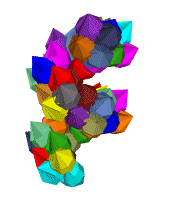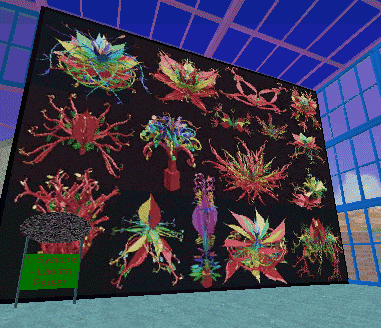|
The above information is giving us the outlines of a Python
Lturtle class. We'd need a current state list, saved state, and
rotation methods. The heading, up and left members of the state
tuple are unit vectors. So we need a vector class -- something like
this:
from coords import Vector
class Lturtle:
stackstate = [] # remembers saved state
delta = 0 # angle of rotation
length = 0.5 # full length of turtle move
thickness = 0.02 # default thickness of cylinder
def __init__(self,vPos=Vector((0,0,0)),
vH =Vector((0,0,1)),
vL =Vector((0,1,0)),
vU =Vector((1,0,0))):
"""The turtle will start at the origin with the
Z-axis as forward direction and Y-axis as left
direction. (lparser.txt)"""
self.vPos,self.vH,self.vL,self.vU = vPos,vH,vL,vU
def turnleft(self):
print "Turn Left by delta"
def turnright(self):
print "Turn Right by delta"
We also need a way to parse Lsystem files, meaning we iterate
through a set of rules (e.g. substitions) a specified number of
times, and feed the resulting string to the Lturtle as a series of
commands e.g. [+F+F+F+F][-F-F-F-F]. We should probably read these
in as text files (.ls) in order to be compatible with a lot of the
work already done.
More information on Lsystems:
In the shoptalk of Lsystems, you start with axioms and rules of
production. An axiom is a string like:
>>> axiom = 'F--F--F'
and your rules of production define substitions, such as:
>>> rules = {}
>>> rules['F'] = 'F+F--F+F'
To apply the rules to an axiom is to scan a string, and
substitute wherever appropriate, e.g. every occurance of 'F' in the
above axiom would be replaced by 'F+F--F+F'.
Since the '-' symbol is not associated with a substition rule,
it would simply pass through as is:
>>> def produce(axiom,rules):
output = ""
for i in axiom:
output = output + rules.get(i,i)
return output
Notice that the dictionary.get() method takes 2 arguments, the
2nd being what to return if the 1st is not a key. For example, if i
= 'F', then the rule for 'F' will be invoked, but if i = '-', then
'-' will simply pass through to the growing output string.
>>> produce(axiom,rules)
'F+F--F+F--F+F--F+F--F+F--F+F'
>>> newaxiom = produce(axiom,rules)
>>> produce(newaxiom,rules)
'F+F--F+F+F+F--F+F--F+F--F+F+F+F--F+F--F+F--F+F+F+F--
F+F--F+F--F+F+F+F--F+F--F+F--F+F+F+F--F+F--F+F--F+F+F+F--F+F'
Another example:
>>> rules = {}
>>> rules['A'] = 'B'
>>> rules['B'] = 'AB'
>>> axiom = 'A'
This sets up the example used at:
http://www.csu.edu.au/complex_systems/tutorial2.html
We'll define iterate as a recursive function:
>>> def iterate(n,axiom,rules):
print axiom
if n>0:
axiom = produce(axiom,rules)
return iterate(n-1,axiom,rules)
>>> iterate(7,axiom,rules)
A
B
AB
BAB
ABBAB
BABABBAB
ABBABBABABBAB
BABABBABABBABBABABBAB
Basically, our Lparser class needs to read in a file consisting
of an axiom and some rules, plus other parameters such as how many
times to recursively apply the rules, what the default angle of
rotation is and so on.
Let's look at a real example of an .ls file, included with the
downloadable DOS version of Lparser at
http://www.xs4all.nl/~ljlapre/lparser.htm:
#===================================================
# Crystals.ls (c) C.J. van der Mark
#
# Questions about Lparser files to:
# Internet cvdmark@xs4all.nl
# Fido 2:283/203.11
# PCG 9:526/464.3
#===================================================
15
20
20
I
I=+(40)ffHccI
H=[+fffG]c[-fffG]c[^fffG]c[&fffG]G
G=[dS]e[d]e[d]e[d]e[d]e[d]e[d]e[d]
e=+(90)f-(90)>(-45)
d={[f+(90)f+(90)f+(90)f>(+38)-(105)ff-(151)ff][f&(38)+(15)ff+(151)ff]}
@
Rules are defined by equal signs. The axiom is given by a letter
alone, after some numbers, in this case I. As per
http://www.xs4all.nl/~cvdmark/tutor.html, the first 3 numbers
represent:
15 # recursion depth
20 # angle
20 # thickness as % of length
In Python:
>>> rules = {}
>>> rules['I']='+(40)ffHccI'
>>> rules['H']='[+fffG]c[-fffG]c[^fffG]c[&fffG]G'
>>> rules['G']='[dS]e[d]e[d]e[d]e[d]e[d]e[d]e[d]'
>>> rules['e']='+(90)f-(90)>(-45)'
>>> rules['d']=('{[f+(90)f+(90)f+(90)f>(+38)-(105)ff-(151)ff]'
'[f&(38)+(15)ff+(151)ff]}')
>>> axiom = 'I'
>>> iterate(2,axiom,rules)
I
+(40)ffHccI
+(40)ff[+fffG]c[-fffG]c[^fffG]c[&fffG]Gcc+(40)ffHccI
And that's only 2 iterations. After 15, we'd have a very long
string of commands to feed to our Lturtle.
Let's use the DOS lparser.exe to generate a Povray file
corresponding to Crystals.ls:
lparser -vc -g Crystals
Running in a DOS box, I get the following output in response to the
above input:
L-System Parser/Mutator v4.0
---------------------------------------------------------
Copyright (C) : RenderStar Technology BV. 1992-1995
Release date : Dec 27 1995 (386+/DOS)
---------------------------------------------------------
Sizing memory
L-system file : .\crystals.ls
Recursion depth: 15
Basic angle : 20
Thickness : 20
Axiom : I
Rule : I=+(40)ffHccI
Rule : H=[+fffG]c[-fffG]c[^fffG]c[&fffG]G
Rule : G=[dS]e[d]e[d]e[d]e[d]e[d]e[d]e[d]
Rule : e=+(90)f-(90)>(-45)
Rule : d={[f+(90)f+(90)f+(90)f>(+38)-(105)ff-
(151)ff][f&(38)+(15)ff+(151)ff]}
Size of string : 41480 chars
Pov file : output.inc
Objects : 5761
End
Then the instructions tell me:
The file 'setup1.pov' can be used to connect to the output.inc
file created with lparser -vc. The first 8 colors in the pov
rendering will then match the ones in the viewer.
 But I didn't get a very good rendering
after all that. Had to tweak it quite a bit (monkey around with
lighting and camera angle). The result is shown at left. But I didn't get a very good rendering
after all that. Had to tweak it quite a bit (monkey around with
lighting and camera angle). The result is shown at left.
As outlined in previous posts, the Lsystem formalism provides
long strings of single-letter turtle commands, e.g.
'FF--FF++&^FF'
In Lapré's version, commands may be followed by a
parameter enclosed in parentheses, e.g. 'F(10)F--(90)FF++(100)'
In Lapré's C implementation, you find a long set of
case-break statements for parsing through these command strings
i.e. we check for:
case item='F' {
dostuff;
break;}
case item='-' {
dostuff;
break;}
and so forth.
Given the long list of single letter commands (about 30 of
them), it makes sense to use a Python dictionary construct coupled
with eval. To each symbol there corresponds the name of a
turtle method, saved as a string. The turtle knows how to convert
returned strings to method names at runtime. Also, the turtle knows
to hold off evaluating a command until it has checked for the
optional following parameter.
Above, I provided the skeletal outline of an Lturtle
class. The Lturtle class below goes a step further, by
accepting long instruction strings via its chomp method.
chomp "eats its way through" the instructions, turning switches
on and off as it tests for "(" and ")" -- the parameter symbols. It
looks up symbols (other than parentheses) in the instrudict
class variable (a dictionary), and builds a command to evaluate --
e.g. self.turnleft(30) -- once parameter checking is complete.
Others will likely come up with simpler versions of chomp
-- some won't like my switch-based approach.
I've only coded stub functions for command symbols f + and -
(even though the dictionary is somewhat more complete). The point
is to test the design. With all of these pieces in place, we've set
the stage to write an Lsystem parser in Python, i.e. to read in the
same files Lapré's lparser.exe accepts, and to have the
output go to Povray for rendering (or other formats, depending how
ambitious we are -- how many wheels we want to reinvent).
I've got more turtle-related code, in connection with Povray in
particular, in Part 4 of my
Numeracy + Computer Literacy series -- lots more clues about
how to proceed with this project.
Whether or not I'll go further down this road myself I don't
know right now. If I do, I'll post further details to the web.
In the meantime, this might be an interesting project for others
to continue and/or adapt to classroom situations. There's lots of
Lsystems literature, positively reinforcing bioform graphical
output, plus a synergy of two topics already covered at the high
school level in many curricula: fractal patterns and turtle
graphics.
In addition, the recursive production rules are good for
reinforcing that algorithms may be alpha-numeric, not just numeric
-- i.e. string and symbol processing is every bit as "mathematical"
(potentially), as anything to do with "raw number crunching" (as
algebraic manipulation so well demonstrates).
classLturtle:
stackstate = [] # remembers saved state
delta = 0 # angle of rotation
length = 0.5 # full length of turtle move
thickness = 0.02 # default thickness of cylinder
instrudict = {'+':'turnleft',
'-':'turnright',
'&':'pitchdown',
'^':'pitchup',
'<':'leftroll',
'>':'rightroll',
'|':'turn180',
'%':'roll180',
'$':'rollhoriz',
'x':'randturn',
't':'gravity',
'F':'fdraw',
'f':'fnodraw',
'Z':'halfdraw',
'z':'halfnodraw',
'g':'Fnorecord',
'.':'Nomove'}
def__init__(self,vPos=Vector((0,0,0)),
vH =Vector((0,0,1)),
vL =Vector((0,1,0)),
vU =Vector((1,0,0))):
"""The turtle will start at the origin with the
Z-axis as forward direction and Y-axis as left
direction. (lparser.txt)"""
self.vPos,self.vH,self.vL,self.vU = vPos,vH,vL,vU
defchomp(self,instructions):
getparam = 0
checkparam = 0
param = ""
for item in instructions:
if getparam: # getting parameter?
if item == ")":
getparam = 0 # done getting
command = command + "(" + param + ")"
eval(command)
continue
else:
param = param + item # building parameter
continue
if checkparam: # checking for parameter?
checkparam = 0
if item == "(":
param = ""
getparam = 1 # parameter exists
continue
else:
command = command + "()" # no parameter
eval(command)
# initializing command string
command = "self." + self.instrudict.get(item)
checkparam = 1 # set flag
else: # dealing with last item
if checkparam:
command = command + "()" # no parameter
eval(command)
deffnodraw(self,n=""):
print "Forward %s (no draw)" % n
defturnleft(self,n=""):
print "Turn Left around vU %s" % n
defturnright(self,n=""):
print "Turn Right around vU %s" % n
|

 But I didn't get a very good rendering
after all that. Had to tweak it quite a bit (monkey around with
lighting and camera angle). The result is shown at left.
But I didn't get a very good rendering
after all that. Had to tweak it quite a bit (monkey around with
lighting and camera angle). The result is shown at left.